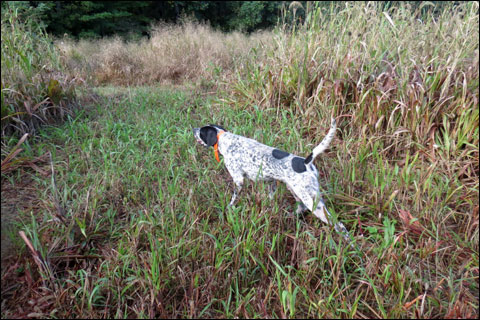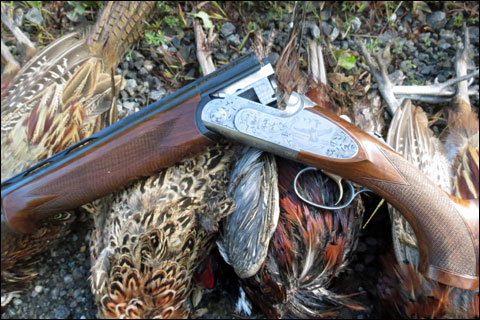The Sabatti Alpen Eagle Takes on the Blue Ridge Mountain Pheasants of Primland

For many of us vintage shotguns serve as time-travel capsules. Their aesthetics and craftsmanship harken to epochs of abundant game across pristine landscapes that nurtured our individual sovereignty and tranquility lost to the blight of smart phones and strip malls.
Sometimes the gentle reversal of time occurs when we initially handle the shotgun; pick it up and you’re immediately there. Otherwise, we gradually slip back in time as our relationship with the shotgun becomes more intimate; the deeper our connection, the more we identify with its heritage.
For me, it was my first side-by-side – an inexpensive 12-gauge Beretta Silver Hawk made in 1960 – that carried me back to the scenic hills of Italy circa La Dolce Vita. The Silver Hawk’s boxy receiver, beavertail forend, meaty stock and rugged reliability felt destined for the Italian working man with thick fingers and broad chest. Certainly utilitarian, the Silver Hawk bestowed a modest sense of pride and glory as evidenced by tiny screws engraved with flower petals, even inside the forend, and the grainy walnut polished with hues of ripe crabapples in sunlight.
And holding that Silver Hawk, walking through harvested pheasant habitats brittle and golden that brushed against me with whispers of the hunt, transported me from the plains of mid-America to the Italian countryside in pursuit of a plump bird for a rustic dinner and local, robust Chianti.
With contemporary break-open Italian shotguns that feeling has become elusive. Some brands are engineered to the point of sterility, others overwrought with pseudo hand engraving and artificially enhanced wood. It’s authenticity, not the prey, that has become endangered for owners of these mid-priced shotguns.
Recently, that vintage shotgun nostalgia once again touched my soul when pheasant hunting with the Sabatti Alpen Eagle over/under at Primland in the Blue Ridge Mountains, Meadows of Dan, Virginia.

The 12-gauge Sabatti Alpen Eagle broken down after a day of pheasant hunting.
The Sabatti Alpen Eagle is old-school Italian in the endearing way that the ideal applies to the likes of Frank Sinatra, an Alfa Romeo Giulietta Sprint and the Riva Tritone mahogany speedboat. Made in Gardone Val Trompia, the Sabatti Alpen Eagle is a masculine, Italian shotgun. Straightforward, handsome and able, the shotgun stirred that sacrament of timelessness as felt with my vintage Beretta Silver Hawk.
At a suggested retail price of about $2,100, the 12-gauge Sabatti Alpen Eagle is for traditionalists with a penchant for affordable Italian bird guns. It’s a seven-pound boxlock with coin-finished sideplates that feature game-scene cameos within acanthus scroll. The walnut stock was finished with a checkered butt. The 14½-inch length of pull measured up to a classic field over/under. The model I shot featured 28-inch barrels and screw-in chokes. It had a semi-pistol grip with a field-grade 5¾-pound single, intertia trigger. An underlug lock-up kept the barrels tight.
As it turns out, the Alpen Eagle is only one of the Sabattis now available in the U.S. The new importer, Italian Firearms Group of Amarillo, Texas, has resurrected the entire Sabatti marque for the first time in this country. IFG now also imports the other Sabatti over/unders including the Falcon, Olimpio, Artimide, Jaguar, the round-body Adler and the Fulgor, CTS and GTX clays guns as well as double rifles and single-shot rifles.
Most Americans probably don’t realize that the Sabatti family featured prominently in Italy’s firearm industry since the early 1700s when Lodovico Sabatti was a famed barrel maker of his generation. The current iteration of the company was founded by Sabatti family members in 1960 dedicated to making shotguns, double rifles and bolt-action rifles.
A pheasant hunt with the Sabatti Alpen Eagle took me into the Blue Ridge Mountains. Pass through the ornate gates of the Primland resort and you’ll drive to a reconditioned lumber road carved into a mountainside up six miles until, at the summit, the 26-room lodge appears with its towering silver silo (actually a professional observatory) joined to the three-story lodge of reclaimed timbers and brick evocative of a Victorian chalet rendered in the 20th century by Frank Lloyd Wright. Overlooking the Highland Golf Course, the entire composition shimmers between the past and future in a purview of natural splendor that embraces 12,000 acres.

At Primland: The beautiful lodge, with one of the spectacular rooms, the lobby and a few of the wine bottles from their vertical cellar.
In 2012, Primland became a LEED registered property. Participation in the voluntary LEED (Leadership in Energy and Environmental Design) process demonstrates leadership, innovation, environmental stewardship and social responsibility that are consistent with the vision of Primland’s founder, Didier Primat who developed Primland and the family members who oversee the eco-luxury resort. The sumptuous cottages and tree houses on the property in turn blend into the natural habitat.
Come 2015 Primland was named in Travel + Leisure’s World’s Best Awards as the Number-Five Resort in the U.S. and Number 23 in the world and was rated one of the Top 10 Luxury Hotels in the U.S. by Trip Advisor. Other recent accolades include The Highland Course rated by Golf Magazine as one of the Top 100 Must Play.
Of Primland’s three restaurants the one called “elements” is the showcase of Executive Chef Gunnar Thompson for his farm-to-table fare with an abundance of wine displayed on the two-story, 2,000-bottle vertical cellar.
By day, Primland’s outdoor activities include fishing, geocaching, bike riding, ATV trail rides and horseback riding. Wing and clays shooters have access to a beautiful sporting clays course, Make-A-Break, Upland Practice Parcours and 5-Stand with spring turkey hunts and seasonal walk-up and European-style driven pheasant drives. Afterwards, be well-advised to visit the dreamy spa and indoor pool.
This time around I spent only 24 hours at Primland with the express intent of trying the Sabatti Alpen Eagle on walk-up pheasants (although there was some extra time for Make-A-Break and sporting clays).

One of Sammy Howell’s Pointers locked onto a pheasant at Primland.
Veteran Primland guide Sammy Howell trained his excellent German Shorthaired Pointers as demonstrated by their quick responses to voice commands. Rain had pounded the region the night before and our day began with wet corn and sorghum lots that affected our early flushes. I compensated by allowing the pheasants to take wing, usually toward the tree-line perimeter, for more challenging shots. The exceptionally warm temperatures dried the crops in short order, as Sammy changed dogs frequently to keep them fresh and safe.
We covered two different fields that morning. Carrying the Sabatti Alpen Eagle between the harvested rows, I slipped into that nostalgic reverie high in the Blue Ridge Mountains as Sammy’s Pointers crashed through the harvests in pursuit of pheasants. We’d catch a point or a surprise flush from the dense stalks and more often than not the Sabatti Alpen Eagle presented a clear view and lethal shot – the birds folding and tumbling in a moment of slow time witnessed from afar.

A few of the pheasants taken at Primland with the Sabatti Alpen Eagle.
The Sabatti Alpen Eagle helped take 10 pheasants in the morning foray. The over/under handled nicely and given the extra distance allowed some birds before triggering a shot the barrels seemed well-regulated. Most unexpected, though, was its low felt recoil firing 1⅛-ounce game loads.
Our morning and afternoon hunts were broken by lunch. We had returned to the Primland Activity Center at the base of the mountain for a quick sandwich. Afterwards, back out again, covering two more food lots that yielded an additional eight pheasants.

Primland guide Sammy Howell as we wrap up our pheasant hunt with the Sabatti Alpen Eagle.
In the end, Sabatti’s Alpen Eagle proved its worth. The shotgun performed well – a steadfast and accurate companion that is fairly priced.
After shooting, we met later in the elements restaurant as the sun set over the mountain through the long expanse of windows. We were seated beside the modern, horizontal fireplace. The neo-classical décor, natural materials and hushed voices from neighboring guests radiated a comfortable warmth especially satisfying after a full day of pheasant hunting. Dinner started with the crawfish and grits appetizer, then moved along to the North Atlantic Salmon (with small potatoes, roasted garlic, roasted brussel sprouts, crispy pork belly and hollandaise) and finished with the dessert of butternut and white chocolate flan. Throughout the meal, a bottle of full-bodied Italian red nurtured over the years by sun, soil and oak eased us into a heavenly evening.
Irwin Greenstein is the publisher of Shotgun Life. You can reach him at contact@shotgunlife.com.
Useful resources:
The web site for the Italian Firearms Group

Irwin Greenstein is Publisher of Shotgun Life. Please send your comments to letters@shotgunlife.com.


Comments